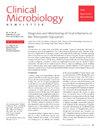第三代新型四环素:依拉瓦环素、奥马达环素和沙环素综述
Q3 Medicine
引用次数: 0
摘要
四环素类抗生素对多种革兰氏阳性、革兰氏阴性和非典型细菌病原体具有活性,它们已被用于治疗各种感染,包括呼吸道感染、皮肤和软组织感染以及性传播感染。与耐多药生物感染有关的发病率和死亡率的增加突出了对新抗生素的需求。2018年,FDA批准了三种新型四环素:依拉瓦环素、奥马达环素和沙环素。本文综述了这些新型四环素的药理学性质、微生物学和临床方面的研究进展。本文章由计算机程序翻译,如有差异,请以英文原文为准。
Review of Novel Third-Generation Tetracyclines: Eravacycline, Omadacycline, and Sarecycline
Tetracycline class antibiotics have activity against a wide range of Gram-positive, Gram-negative, and atypical bacterial pathogens, and they have been used for treatment of various infections, including respiratory infections, skin and soft tissue infections, and sexually transmitted infections. Increases in morbidity and mortality associated with infections by multidrug-resistant organisms have highlighted the need for new antibiotics. In 2018, three novel tetracyclines were approved by the FDA: eravacycline, omadacycline, and sarecycline. This review discusses the pharmacological properties and microbiological and clinical aspects of these new tetracyclines.
求助全文
通过发布文献求助,成功后即可免费获取论文全文。
去求助
来源期刊

Clinical Microbiology Newsletter
Medicine-Infectious Diseases
CiteScore
2.20
自引率
0.00%
发文量
35
审稿时长
53 days
期刊介绍:
Highly respected for its ability to keep pace with advances in this fast moving field, Clinical Microbiology Newsletter has quickly become a “benchmark” for anyone in the lab. Twice a month the newsletter reports on changes that affect your work, ranging from articles on new diagnostic techniques, to surveys of how readers handle blood cultures, to editorials questioning common procedures and suggesting new ones.
 求助内容:
求助内容: 应助结果提醒方式:
应助结果提醒方式:


